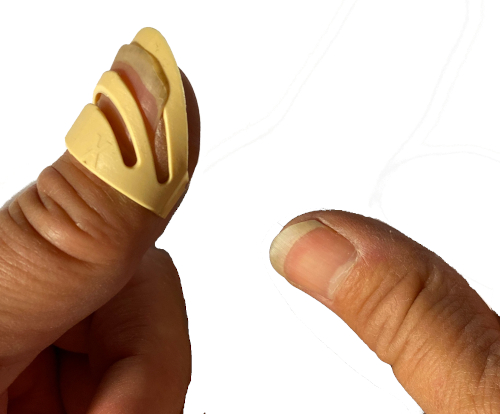Home > Info > How To Play > How to Care for Thumbnails

For centuries, kalimba players have grown their thumbnails long to help them play for hours without pain. But what if you don’t have that kind of thumbnail? Read and learn! Alaska piks are an easy pain free alternative… or have you tried super glue on your nails?

Father Dos Santos, the first European to document the kalimba in 1586, wrote that the players “play upon this instrument by striking the loose ends of the rods with their thumb nails, which they allow to grow long for that purpose, and they strike the keys as lightly as a good player strikes those of a harpsichord.”
More recently, when Paul F. Berliner went to Zimbabwe (the country called Rhodesia at that time) in the 1970s, players sometimes used metal wires on their thumbs to play mbira tines to spare their thumbs. (See illustration.)

I recommend that people play with their thumbnail instead of the thumb flesh. Playing with your nail will permit you to play for hours without pain. Actually, I recommend that just before you pluck a tine with your nail, you lightly touch the tine first with your thumb flesh, to deaden any vibrations that might be ongoing so the hard nail doesn’t make an ugly ZZZZT sound when it touches a vibrating tine. In one motion with the initial flesh touch of the tine, drag the nail off of the tip of the tine, angling down as you come off, but not pushing down very hard at all. Even with a short nail, pointing the thumb tip down will allow the nail to contact the tine.
On the other hand, there are players such as Kevin Spears for whom playing with the flesh of their thumbs is part of their technique. I have known several people who started out playing this way but ended up switching to playing with their nails. It’s a personal choice, and you’ll figure it out on your own.
During the beginning stages of playing the kalimba, almost everyone’s thumb flesh hurts, even if you are playing with your nails – but over time, you will develop small calluses on your thumbs, and you will have no more pain. I have tiny ones right under my thumb nails. If you play with your thumb flesh, your eventual calluses will be much larger.

Do you need ALASKA PIKS?
If for any reason you can’t grow your thumb nails, for example if you are a massage therapist, you can use Alaska Piks, which are available in guitar shops in your town or at the Kalimba Magic Shop. I like Alaska piks because they are made well and they are plastic and not metal, which means they do not click loudly on the metal kalimba tines as you play. Alaska Piks are sized for fingers (for guitar playing), and not thumbs. They are also expandable. Keep these things in mind when you are choosing some Alaska Piks for your thumbs. See the chart below.

ALASKA PIK SIZE CHART
Alaska Piks, originally intended for guitar playing, are made for any other fingers than thumbs…so we have translated the sizes, and created a chart just for using them on your thumbs. The numbers on the left of our chart represent the circumference of the thumb (measured at the base of the thumb nail, approximately), and the letters on the right are the associated Alaska Pik size. In this system, children use M, young teenagers and small-handed women might use L, and anyone with normal to large hands use XL. Remember, these are sizes meant for fingers; if you have very large thumbs you are likely outside of the available size range. Sorry!
CRACKING, STRENGTHENING REMEDIES, FILING
Sometimes I don’t keep my thumb nails at their optimum length for playing (just forget to trim them). When they get longer, they tend to get brittle. At those times, while reaching for something (a door or a drawer handle) I might accidentally jam a thumb nail against a hard surface, folding the nail over. (When the nails are this long, it doesn’t really hurt.) But within an hour, I will often notice a crack on one end of the nail, that has not traveled all the way across. If left untreated, this crack will eventually spread across to the other side and the nail’s tip will soon come off.
There are two things I have done to remedy this. First, if the crack is only a quarter inch or less, I will clip off the cracked part of the nail, possibly removing a sizable chunk of the nail, but leaving most of it. File down the sharp corners and edges so you aren’t a danger to yourself or others. You can either play with the remaining nail, or it works great to support an Alaska pik.
The other approach is Krazy Glue: you can actually glue over the crack to prevent further cracking. On more than one occasion my thumb nail broke straight across and I successfully glued the whole thing back on. In these situations it might be necessary to reapply glue every two or three days until the break grows out. Krazy Glue is available in a bottle with a little brush applicator, perfect for fixing thumb nails. You can actually paint your nails with this glue to strengthen them and help prevent breaks and to help slow nail erosion due to lots of kalimba playing. You could also have acrylic overlays applied professionally to your nails. This is a solution guitarists often speak very highly of. These are among the best answers to nail wear or breakage.
If you play kalimba hard for an hour or two in one day, you will find that the thumb nail will still wear away at the place you tend to strike the kalimba tines. You will want to file the nail until the profile is straight or curved in a convex shape to improve your playing the next time you play.
It can also be useful to shape your nails differently for different kalimbas. The Pentatonic kalimba likes flatter nails because there is a bigger distance between tines and a pointier nail tends to get caught in between – a flatter nail profile can also play two adjacent tines simultaneously. On the other hand, the Treble kalimba with its small and close tines prefers pointier nails.
LENGTH CONSIDERATIONS
If your nails are too long, they are liable to break. If they are too short, you can’t do the glissando, or you will wear them down too quickly. So, there is an optimal nail length that gives you enough to work with, but not so much that you will break it off, leaving nothing. Find your own sweet spot. I actually like to play when my nails extend about 3/16 of an inch beyond my thumb flesh, but they tend to break at this length, so it’s just too long! About 1/8 of an inch, as shown in the photo, is a really good balance between length and practicality for me.
Nails that are longer than optimal, and not hardened, can also make a sound that is objectionable as you play. Work around this by playing closer to the left or right side of the nail, use Krazy glue to harden them, or just keep them short enough. By the same token, just after you clip your thumbnails, you will find there is a clicky attack to your kalimba playing. It will either take a few days of normal living, or a few hours of kalimba playing, to smooth your nails enough to eliminate that clicky sound. Personally I prefer to file my nails every few days, rather than waiting to cut them. Filing does help eliminate some of this issue, but not all of it. So file after you cut your nails, and play lots of kalimba!
If you have any questions, feel free to contact us via the email form, or speak directly to Mark Holdaway at 520-488-7641.Contact Us


Sign up for our newsletter and free resources with your email address:
We pinky promise not to spam you and to only send good stuff.
 Christmas in July 2025
Christmas in July 2025 Patriotic and American Music for Kalimba
Patriotic and American Music for Kalimba